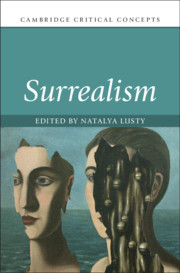Book contents
- Surrealism
- Cambridge Critical Concepts
- Surrealism
- Copyright page
- Contents
- Illustrations
- Notes on Contributors
- Acknowledgments
- Introduction: Surrealism’s Critical Legacy
- Part I Origins: Ideas/Concepts/Interventions
- Part II Developments: Practices/Cultures/Material Forms
- Part III Applications: Heterodoxies and New Worlds
- Chapter 14 Surrealism and Schizoanalysis
- Chapter 15 The Surrealist Bestiary and Animal Philosophy
- Chapter 16 Picasso’s Habits: André Breton on Art, Nature and Reflexivity
- Chapter 17 Surrealism and Mass-Observation
- Chapter 18 Pacific Surrealism
- Chapter 19 Decolonial Surrealism
- Chapter 20 Surrealism and écriture féminine
- Chapter 21 Subcultural Receptions of Surrealism in the 1960s International Underground Press
- Select Bibliography
- Index
Chapter 19 - Decolonial Surrealism
from Part III - Applications: Heterodoxies and New Worlds
Published online by Cambridge University Press: 23 July 2021
- Surrealism
- Cambridge Critical Concepts
- Surrealism
- Copyright page
- Contents
- Illustrations
- Notes on Contributors
- Acknowledgments
- Introduction: Surrealism’s Critical Legacy
- Part I Origins: Ideas/Concepts/Interventions
- Part II Developments: Practices/Cultures/Material Forms
- Part III Applications: Heterodoxies and New Worlds
- Chapter 14 Surrealism and Schizoanalysis
- Chapter 15 The Surrealist Bestiary and Animal Philosophy
- Chapter 16 Picasso’s Habits: André Breton on Art, Nature and Reflexivity
- Chapter 17 Surrealism and Mass-Observation
- Chapter 18 Pacific Surrealism
- Chapter 19 Decolonial Surrealism
- Chapter 20 Surrealism and écriture féminine
- Chapter 21 Subcultural Receptions of Surrealism in the 1960s International Underground Press
- Select Bibliography
- Index
Summary
This chapter tells the story of surrealism during the period of decolonization (and neoliberal re-entrenchment) that extends roughly from the end of World War II to the contemporary moment. It traces the overlapping but also discontinuous genealogies according to which anticolonial movements throughout the world – and in particular throughout the Global South – drew upon, rejected, and reinvented surrealist thinking. By studying surrealism as an anticolonial movement, this chapter inverts the common narrative by which it originated in Paris after World War I and “spread” to other countries, whether through the travels of individual European artists and writers, or through groups of second-order adherents. In place of a set of surrealist techniques and adherents disseminated throughout the nether reaches of the colonial world, this chapter explores the ways in which anticolonial thinkers throughout the Global South, particularly in North Africa and throughout the Americas, have built Afro-Caribbean, tricontinental, pan-African, and otherwise trans-Oceanic networks of artistic and political activity through the medium of a surrealist movement rendered plastic through translation.
Keywords
- Type
- Chapter
- Information
- Surrealism , pp. 342 - 362Publisher: Cambridge University PressPrint publication year: 2021



